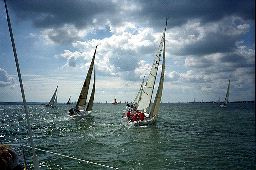
Hinzite Summer Tour 2002
by Craigge Smith
a travelogue after the style of
Philip Greenspun

a travelogue after the style of
Philip Greenspun
|
Cowes Race Week, 2002 Computer Details Portsmouth Dockyards The HMS Warrior The HMS Victory Get Your Kit On Osborn House Crew Ball Across the Bay of Biscay La Corunna, Spain Porto, Portugal Lisbon |
As the long flight across the Atlantic comes to and end, the English
country side comes into view. The fields are divided, like a patchwork
quilt, into ancestral farming plots. We clear customs and head for the
Red Jet: the fastest way to get to the Isle of Wight.
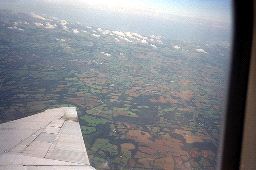
Hinzite is a 47 foot Frers designed aluminum hull. Newer boats of glass
or carbon fiber composites weigh significantly less, but rate the same.
But then we're here for the experience with little expectation of
prying trophies away from the blue bloods. Every boat requires maintenance,
and "This old boat" is no expectation. She's been laid up in Sweden
over the winter and developed a growth of black fungus through out. Thankfully,
that's already been removed, but the transmission been giving problems.
We call the boat's cell phone and learn we have time for a pint
before she'll arrive. When she does, we go to work converting her
from cruising to racing mode. The v-berth has to come out, and all the
non-essential gear. Then we go to work on the winches. Jay climbs the mast
to check the halyards and nav lights.

 The
next morning, there are over a thousand boats from skiffs to the massive
Thames barges with double gaff rigs.
The
next morning, there are over a thousand boats from skiffs to the massive
Thames barges with double gaff rigs.
Before the age of steam, their tall masts helped get these traders
farther up river and closer to market. When the tide went out, they sat
comfortable on their flat bottoms. With a wishbone rig, instead of a boom,
they could tack with haystacks as high as 12 feet on deck.
 Kingfisher,
Ellie MacPherson's circumnavigating catamaran hangs on a buoy. Rumored
to be for sale, we ogle as the prospective buyers prepare to make way.
Jonathan is off the boat today, so David will helm, and I'm to run
the nav station. But the air is light and the RC eventually abandons all
races.
Kingfisher,
Ellie MacPherson's circumnavigating catamaran hangs on a buoy. Rumored
to be for sale, we ogle as the prospective buyers prepare to make way.
Jonathan is off the boat today, so David will helm, and I'm to run
the nav station. But the air is light and the RC eventually abandons all
races.
 We
head back to the dock with a thousand other boats as the ferry prepares
to leave.
We
head back to the dock with a thousand other boats as the ferry prepares
to leave.
 Back
in the village, a pair of long legged Irish dancers entertain the crowd.
Back
in the village, a pair of long legged Irish dancers entertain the crowd.
The abandonment gives a time to prepare for our crew dinner. Lynn, Sherri
and Ingrid have offered to cook dinner; we're to bring the
wine. This gives the crew a chance to get to know each other.
|
Lynn and Sherri going,
|
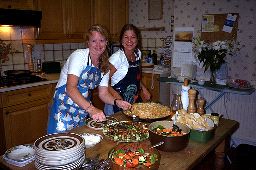 |
|
going ...
|
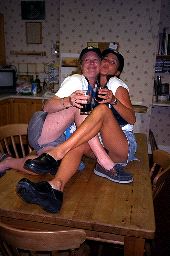 |
|
gone.
|
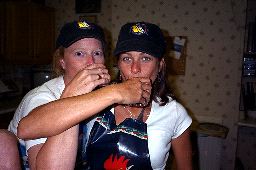 |
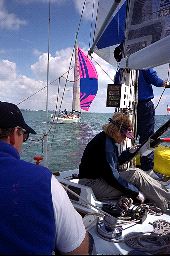
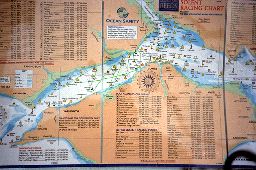
After the race, we clean the lines and clean up the boat. Back at the
dock, we provision the boat for the next day with lots of fluids, getting
these in the refrigerator early let's the engine cool it down, since
the AC compressor isn't working. The village supplies everything
a sailor could want: supplies, repairs, food, drink, music, and camaraderie
with sailors.
There's 18 of us, boat the boat only requires a crew of 13,
so we take turns playing tourist. This is my day off the boat, so Kathryn,
Rick and I head over to Plymouth. Before the day is over, will will have
travel in boats, buses, taxis, ferries, and trains. We walk to the "chain
ferry" to East Cowes where we catch the bus for Ryde. There we board a
train out to the end of the pier to catch the "fast ferry" - a high
speed catamaran, and arrive in Portsmouth.
 You've
heard of "Gunboat Diplomacy?" This is the boat. She never fired
a shot in anger. She never had to. The British would just open all
those gun-doors, and dictate terms. Built in 1860, she would sail at 13
knots, or steam at an impressive 14 knots with her 1250 horse power coal
fired steam engine. The men were paid 50% more than on other ships of the
line due to the dreadful working conditions: shoveling coal and ash at
temperature up to 110 F. The amazing part thing is, despite her wrought
iron plate over 18" solid teak construction, she was still a classic square-rigger.
The cannons, though larger, were still run out with block and tackle.
You've
heard of "Gunboat Diplomacy?" This is the boat. She never fired
a shot in anger. She never had to. The British would just open all
those gun-doors, and dictate terms. Built in 1860, she would sail at 13
knots, or steam at an impressive 14 knots with her 1250 horse power coal
fired steam engine. The men were paid 50% more than on other ships of the
line due to the dreadful working conditions: shoveling coal and ash at
temperature up to 110 F. The amazing part thing is, despite her wrought
iron plate over 18" solid teak construction, she was still a classic square-rigger.
The cannons, though larger, were still run out with block and tackle.
 Lord
Nelson's flagship is a magnificent sight as she sits in dry dock.
We enter and make our way to the gundeck. There were few comforts on a
ship like this. Buckets everywhere - a good idea aboard a wooden
war ship loaded with gun powder- bear the insignia of the kind. Rick points
to the chalkboard with Nelson's motto "England expects every man
to do his duty" and signal 16 (engage the enemy more closely). This may
have contributed to Nelson's success since most of the canons were
ineffective except at point blank range. A brass plaque shows the spot
where Nelson stood when the French sniper mortally wounded him during the
Battle of Trafalgar.
Lord
Nelson's flagship is a magnificent sight as she sits in dry dock.
We enter and make our way to the gundeck. There were few comforts on a
ship like this. Buckets everywhere - a good idea aboard a wooden
war ship loaded with gun powder- bear the insignia of the kind. Rick points
to the chalkboard with Nelson's motto "England expects every man
to do his duty" and signal 16 (engage the enemy more closely). This may
have contributed to Nelson's success since most of the canons were
ineffective except at point blank range. A brass plaque shows the spot
where Nelson stood when the French sniper mortally wounded him during the
Battle of Trafalgar.  We
continue deep down, below the waterline, to the Orlop deck where Nelson
died. He had lived to hear of the success of the battle, but didn't
want to be buried at sea, so they placed his body in a barrel of sprits.
Spotting a few barrels near his last resting-place, I naively ask the guide
"Is that the barrel they put him in?" She smiles and shakes her head no.
I latter lean the ship has been so thoroughly restored virtually none of
the original wood remains save the keelson. Upon closer inspection, the
four great anchors and most of the cannon turn out to be fiberglass replica.
A ship in dry dock wouldn't be able to carry that much weight I'm
told.
We
continue deep down, below the waterline, to the Orlop deck where Nelson
died. He had lived to hear of the success of the battle, but didn't
want to be buried at sea, so they placed his body in a barrel of sprits.
Spotting a few barrels near his last resting-place, I naively ask the guide
"Is that the barrel they put him in?" She smiles and shakes her head no.
I latter lean the ship has been so thoroughly restored virtually none of
the original wood remains save the keelson. Upon closer inspection, the
four great anchors and most of the cannon turn out to be fiberglass replica.
A ship in dry dock wouldn't be able to carry that much weight I'm
told.
 The
girls egg us on, having already entered a contest at the lifeboat station.
The idea of "Get you kit on" is to don a full survival suit, lifejacket,
helmet, and safety tether faster than any other side. Every participant
gets a free T shirt. This is presumably to raise awareness of the important
job these volunteers performed. In an island nation, the lifeboatmen provide
an essential service without any government funding. Rather, replica lifeboat
coins boxes collect spare change at shops and pubs.
The
girls egg us on, having already entered a contest at the lifeboat station.
The idea of "Get you kit on" is to don a full survival suit, lifejacket,
helmet, and safety tether faster than any other side. Every participant
gets a free T shirt. This is presumably to raise awareness of the important
job these volunteers performed. In an island nation, the lifeboatmen provide
an essential service without any government funding. Rather, replica lifeboat
coins boxes collect spare change at shops and pubs.

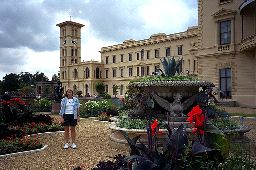 I'm off the boat again today, so Kathryn and I visit Queen Victoria's
summer residence on the Isle of Wight. The buildings house collections
of art and kick-nacks from natural history to steam engines. The exotic
Dunbar room is the best. Inlaid wood and intricate plaster ceilings. The
walled gardens and grounds delight Kathryn. The day is windy and in the
distance, we see boats on the eastern Solent.
I'm off the boat again today, so Kathryn and I visit Queen Victoria's
summer residence on the Isle of Wight. The buildings house collections
of art and kick-nacks from natural history to steam engines. The exotic
Dunbar room is the best. Inlaid wood and intricate plaster ceilings. The
walled gardens and grounds delight Kathryn. The day is windy and in the
distance, we see boats on the eastern Solent.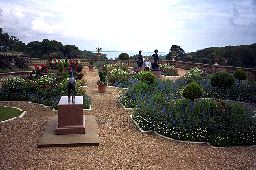
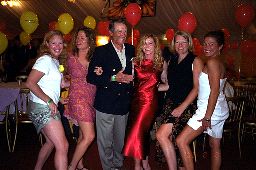
The ball is a relax affair. The food isn't exceptional, but there's
a live band and free Mt Gay T-shirts and hats for all.
 With
the races over, it's time to put the boat back into cruising mode.
An amazing array of personal and race gear is tossed onto the docks, to
be replaced with even more for the container: 2nd life raft, dingy, outboard
engine, v-berth, sextant, etc. The V birth is chock full from sole to headliner.
Since we aren't racing, we don't mind the extra weight. We
motor over to the fuel dock and fill up on diesel and drinking water. Meanwhile,
Lynn, Sheri, and Franco returned with provisions for the crossing: 4 days
of food and drink for 8 people and find we're gone. They track us
down and we improvise a sort of bucket brigade to get everything aboard.
There's little time for go byes as we're in a rush to leave
with the tide. We head out towards the needles while Jimmy goes a lot to
sort out the lazy jacks. Lynn prepares Cornish Pasties for everyone. The
winds are light, but the sea is lumpy.
With
the races over, it's time to put the boat back into cruising mode.
An amazing array of personal and race gear is tossed onto the docks, to
be replaced with even more for the container: 2nd life raft, dingy, outboard
engine, v-berth, sextant, etc. The V birth is chock full from sole to headliner.
Since we aren't racing, we don't mind the extra weight. We
motor over to the fuel dock and fill up on diesel and drinking water. Meanwhile,
Lynn, Sheri, and Franco returned with provisions for the crossing: 4 days
of food and drink for 8 people and find we're gone. They track us
down and we improvise a sort of bucket brigade to get everything aboard.
There's little time for go byes as we're in a rush to leave
with the tide. We head out towards the needles while Jimmy goes a lot to
sort out the lazy jacks. Lynn prepares Cornish Pasties for everyone. The
winds are light, but the sea is lumpy.
I sent the following email from the ship's Sat phone.
From: Hinzite [hinzite@stratosnet.com]
Sent: Monday, August 19, 2002 12:52
To: shipslog@hinzite.com
Cc: crewupdate@hinzite.com
Subject: The yacht Hinzite crosses the Bay of Biscay
Inky star-less nights, huge seas with boarding waves, gusts to 50 knots -- that's what we expected crossing the infamous Bay of Biscay and the legendary "Cape of Death."We take our departure from Cowes with the favorable tide on Mon 8/12 . Eight able-bodied sailors are aboard: Chuck, Jimmy, Larry (Doc), Jonathan (the Chief), Jay, Ingrid, Lynn, and Craig (Craiggae). Sailing west, the Needles -- a series of chalky sea stacks eroded from the western extremes of the Isle of Wight -- make for a dramatic sight illuminated by the golden glow of the setting sun. Then we spot it: Rip Tide to starboard! A confused sea signals dangerous shallows. The helm is put over hard to port 40 degrees as we see the bottom. Disaster averted, Lynn passes out Cornish Pasties -- kept warming in oven -- to the crew. We will come to appreciate, in the days to come, her haute cuisine on the high seas, literally transforming Hinzite into a floating 4 star restaurant.
Rounding Pt Quessant in the early hours Tues morn, the crew is miserable. Rain, fog, and lack wind forcing us to start the engine. The diesel fumes don't help the Mal de Mere most of the crew is suffering. And the most careful navigatation is required along the fringes of the forbidden zone least we wander into busy shipping lanes. But Chuck has the situation well in hand with waypoints loaded into all 3 of our redundant GPS systems, while the lighthouses along the coast of France provide reassuring beacons.
On Wed we enter the Bay of Biscay. The fog has lifted and fair winds allow us to unfurl the headsail. We're happy to be sailing, but the extended motoring has seriously depleted our supply of diesel and we discover that we've exhausted our primary fresh water tank. Will we run our of fuel or water first? The remaining water tank has a distinctly unpleasant taste. "That should make water rations unnecessary" quips the Chief. We befriend a lost and exhausted little bird who has decided to take refuge on our deck while dolphins cavort in our bow waves. Everyone is in good spirits as Lynn serves up hot noodles while we watch the sun sink into the Atlantic and Craiggae belts out "Strike the Bell." Chuck has been feverishly working on the RO water maker and now proudly displays the fruits of his labors: a single liter of sweet-sweet tasting water! Like a child with a new toy, he patently fills all our bottles over the course of the next few hour (4.5 quarts/hour).
Thursday, 8/15, we motor-sail past a lone sailboat. Part of the Cowes-Vigo race the left the day before us? We hail them on VHF but no reply. Perhaps they aren't listening, or don't want to appear to infringe the outside assistance rule? The winds come up from behind and we set the 1.5 oz chute and sail along happily. More dolphins play in our bow waves.
Friday, we see a pod of 3 whales spouting along. Since we're running low on fuel, and Jimmy needs to make a connection, Chuck decides we'll put into La Coruna instead of Vigo. The mountain tops of the Iberian peninsula hove into sight -- the first land we've seen in 4 days. Ingy hails the marina and we hear "Hinzite Hinzite Hinzite" booming out over the water. It takes us a moment to realize they've piped the VHF into the PA system (not at the desk?) -- It's Ingy's own voice we hear booming across the water from shore! We tie up the boat and toast each other: we've done it! We've crossed the Bay of Biscay. We wash down the boat and head for the showers -- our first in 4 days -- a pleasure I can't even begin to describe.
Current position N 42 51' W 09 20' -- 3 miles west of Cape Finisterre. Stay tuned -- more details to follow.
-----------------
Copyright (c) 2002 Craig A. Smith
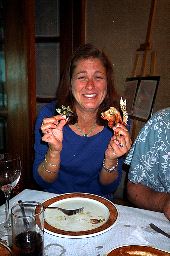

La Coruna is a delightful town with cobblestone streets and electric
trolley cars. The old fort dominates the yacht basin. As you might expect,
the seafood is wonderful if not unusual. Lynn glances skeptically at a
plate of steaming barnacles. Who knew they were edible? We don't
speak Spanish, but a friendly man gestures how we're to use the
straight pins, served in a cork, to pick out the meat.
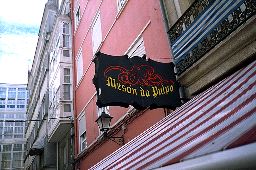

At the crowded Mesón do Pulpo (House of Octopus), pulpo is the
first item on the menu. It's the second item as well. In fact almost
all the dishes feature or contain some octopus. There's plain pulpo,
pulpo with extra pulpo, pulpo fried in its own ink, pulpo pulpo-pulpo-pulpo-baked
beans and pulpo (that's not got much pulpo in it ;-).
 We
take a trolley to the Torre De Hercules.
We
take a trolley to the Torre De Hercules. 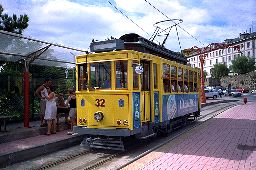 This
Roman lighthouse was originally built in the early 1st century BC, but
was abandoned and neglected after the Romans left in the 5th century AD,
Since 1790 the tower has served as an navigational signal using first olive
oil, then paraffin lamps and Frenel lens. The light was electrified in
1927. Jimmy caught a train and we're reprovisioned the boat;
time to shove off for Portugal.
This
Roman lighthouse was originally built in the early 1st century BC, but
was abandoned and neglected after the Romans left in the 5th century AD,
Since 1790 the tower has served as an navigational signal using first olive
oil, then paraffin lamps and Frenel lens. The light was electrified in
1927. Jimmy caught a train and we're reprovisioned the boat;
time to shove off for Portugal.
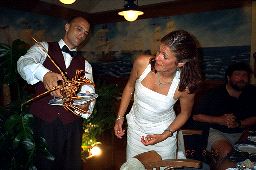 We
arrive late and head for the first place to eat. We ogle the large tanks
of lobsters lining the entrance while we sip chilled white port and wait
for our table. Not bad for the city know for its tripe eaters. Lynn decides
to be intrepid and orders a lobster at market price. Either out of custom,
or to check they got the order right, they bring a live, squirming lobster
to the table for Lynn's inspection. This is not what she was expecting,
and we're slightly amusing as she reconsiders. Believing this to
be one of the creatures she befriended in the entrance, she protests "I
can't eat him, he's my friend." Reassure only the largest
we're spared for display, she bravely agrees and sealing this spiny
fellow's fate as he waves his antenna in vain. That won't
be the last surprise. When the bill is presented, Jonathan learned that
"market price" is E100 per kilogram. "What the heck?" he says, and in a
class act, picks up the whole tab.
We
arrive late and head for the first place to eat. We ogle the large tanks
of lobsters lining the entrance while we sip chilled white port and wait
for our table. Not bad for the city know for its tripe eaters. Lynn decides
to be intrepid and orders a lobster at market price. Either out of custom,
or to check they got the order right, they bring a live, squirming lobster
to the table for Lynn's inspection. This is not what she was expecting,
and we're slightly amusing as she reconsiders. Believing this to
be one of the creatures she befriended in the entrance, she protests "I
can't eat him, he's my friend." Reassure only the largest
we're spared for display, she bravely agrees and sealing this spiny
fellow's fate as he waves his antenna in vain. That won't
be the last surprise. When the bill is presented, Jonathan learned that
"market price" is E100 per kilogram. "What the heck?" he says, and in a
class act, picks up the whole tab.
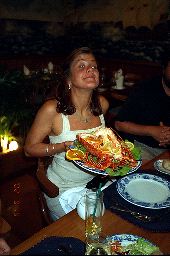
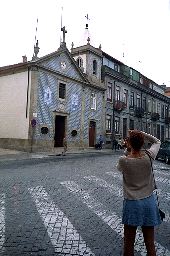

The next morning, we go exploring. Churches, and the train station,
are covered with blue and while tile, city is roofed in red tile. We head
down narrow streets and cross the river to find the wine cellars.

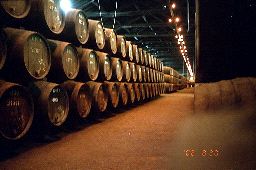
Port is fortified with distilled spirits, but comes in many varieties
from chilled whites, through the tawnies and late bottle vintages.
Porto is the birth place of King Henry the Navigator. A monument just outside the old stock exchange commemorates his humble birth place. Legend has it the city provisioned him with the best cuts of meat and keep the offal for themselves, hence the moniker "tripe eaters." No photos are permitted inside the old and elegant stock exchange which served as a chamber of justice for a time. In a small room where the judges deliberated, I'm delighted by the most amazing oil paintings.
 My
time has run out. We take the train to Lisbon. I catch a glance of the bridge
over the Tagus River as the plane takes off. Sadly, this is all I'll
see of Lisbon on this trip.
My
time has run out. We take the train to Lisbon. I catch a glance of the bridge
over the Tagus River as the plane takes off. Sadly, this is all I'll
see of Lisbon on this trip.